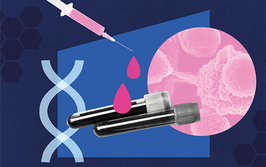In a Swipe of a Swab
Researchers believe a simple oral swab test could overcome the limitations of standard sputum testing methods for tuberculosis
Although mortality rate has seen a big decline, pulmonary tuberculosis (TB) remains the second biggest killer from a single infectious agent: according to WHO, 9 million people fell ill with TB in 2013, 1.5 million died from it (1). While a diagnosis is usually done using microbiological, microscopic, or molecular analysis of sputum, this form of test has its challenges. Given the global burden of TB, it’s clear an alternative is needed. And researchers from the Universities of Washington, USA and Cape Town, South Africa, think they might have found it – in a test that involves using a $1 cheek swab.

Dilutions of mycobacterium tuberculosis H37Ra, a nonvirulent strain, were tested in the Cangelosi Lab. Photo credit: Sarah Fish, University of Washington, USA.
Bacteria like to stick to surfaces, which inspired the team to conjecture that TB pathogen cells can be found attached to the inner surfaces of the mouths of people with active disease. “The swab is used to gently scrape the interior of a person’s cheek and the material collected by the swab is then tested by a standard PCR test for Myobacterium tuberculosis DNA,” explains lead author of the associated paper (2), Gerard Cangelosi. “One of our collaborators, Lisa Jones-Engel, showed the method can work in veterinary applications, which was what prompted us to try it out in humans. This is an example of a “One Health” approach to improving human healthcare,” adds Cangelosi.
So how did they go about testing the hypothesis? The team collected three swabs each from 20 subjects with active pulmonary TB and from 20 healthy controls. Those samples were then tested using a PCR-specific to the M. tuberculosis IS6110 insertion element. And the result? At least two positive swabs for 18 of the 20 test subjects (90 percent); all healthy control samples were negative. “This initial proof-of-concept project used a small sample set,” says Cangelosi, “and the results suggest that the method can be used for the most common form of TB, but large samples are needed.” He believes if larger samples continue to show promise, the method may facilitate TB case finding in several ways, including improving identification of people with active TB in large numbers before they have a chance to spread disease to others; so “active case finding,” a long-sought goal in TB control. It could make it easier to diagnose TB in remote settings too, and it may also make it easier to diagnose pediatric TB.
Why is an alternative actually needed? Sputum has several limitations: it’s difficult for some patients (especially children) to produce, its viscosity restricts test sensitivity, and its production requires patients to cough, thus posing a threat to healthcare workers.
The advantages of an oral swab are clear: it’s fast and easy to collect, samples are easier than sputum to analyze, and they pose a lower risk to others. “We consider it unlikely that our method can totally replace sputum testing. However, it may simplify TB diagnostic and screening tasks that are not currently easy with sputum analysis. And possibly, it may enable active case finding strategies that are not possible with sputum analysis,” explains Cangelosi.
What’s next for the team? They’ll repeat the proof-of-concept study in a larger subject sample in South Africa and the USA. They also plan to demonstrate efficacy in pediatric patients. If all goes according to plan, “We will then work to develop point-of-care testing methods that exploit the unique advantages of oral swabs,” Cangelosi confirms.
- World Health Organization, “Global tuberculosis report 2014”, (2014). Accessed April 16, 2015. bit.ly/1mEYVYR.
- RC Wood, et al., “Detection of Myobacterium tuberculosis DNA on the oral mucosa of tuberculosis patients”, Nature Sci Rep, 5, 8668 (2015).PMID: 25727773.

After graduating with a pharmacology degree, I began my career in scientific publishing and communications. Now with more than 16 years of experience in this field, my career has seen me heading up editorial and writing teams at Datamonitor, Advanstar and KnowledgePoint360 group. My past experiences have taught me something very important – that you have to enjoy working with, and have respect for your colleagues. It’s this that drew me to Texere where I now work with old colleagues and new. Though we are a hugely diverse team, we share several things in common – a real desire to work hard to succeed, to be the best at what we do, never to settle for second best, and to have fun while we do it. I am now honored to serve as Editor of The Pathologist and Editorial Director of Texere Publishing.




















